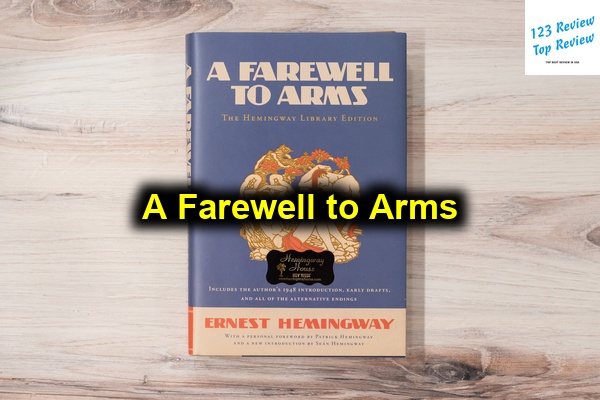This semi-autobiographical novel, published in 1929, revolves around the experiences of a young American lieutenant in the Italian army during World War I. Its vivid portrayal of love amid the chaos of war, coupled with profound themes of despair and isolation, makes it a poignant exploration of human experience in times of tumult.

In this review, 123 Review will dissect the novel’s themes, character analyses, writing style, critical reception, historical context, adaptations, and its lasting legacy.
Themes of A Farewell to Arms
Love and War
At the heart of A Farewell to Arms lies a compelling exploration of love juxtaposed against the backdrop of war. The relationship between Frederic Henry and Catherine Barkley serves as both a sanctuary and a source of conflict in a world ravaged by violence. Hemingway captures the intensity of their love through moments of tenderness amid the surrounding chaos, revealing how love can provide solace and a sense of purpose even in the darkest times. Their love story embodies the struggle against the inevitable loss brought by war, highlighting the fragility of human connection when faced with external destruction.
Catherine’s character embodies the nurturing qualities of love, often serving as a stabilizing force for Frederic. As they navigate the trials and tribulations of the war, their bond deepens, revealing the profound effects of human relationships under strain. However, this love also exposes vulnerabilities, illustrating how war’s impact is not only physical but also profoundly emotional and psychological.
The Absurdity of War
Another central theme in A Farewell to Arms is the absurdity of war. Hemingway, drawing on his experiences, portrays warfare as chaotic, irrational, and ultimately futile. The brutal realities of life on the front lines reveal the senseless loss and suffering endured by both soldiers and civilians. Frederic’s journey takes him through horrific battles, witnessing the disintegration of human life and the arbitrary nature of survival. The novel’s opening chapters, filled with descriptions of wounded soldiers and the relentless bombardment, set the stage for this exploration of the absurd.
As Frederic grapples with the absurdity of his situation, he often questions the motivations behind the war, leading to an existential crisis marked by a growing disenchantment. This theme challenges romantic notions of heroism and glory in warfare, instead painting a stark picture of disillusionment and despair.
Isolation and Despair
Isolation is a recurring motif throughout the novel, emphasizing the emotional distance experienced by soldiers. Despite the camaraderie among troops, Frederic often feels alone, grappling with his thoughts and fears. This isolation is mirrored in Catherine, who faces her struggles in a world dominated by men and violence. Their attempts to find connection amid the turmoil become increasingly difficult as the war progresses, leading to profound feelings of despair.
Ultimately, Hemingway delves into the psychological effects of war, depicting how isolation can lead to a sense of hopelessness. The characters’ struggles serve as a commentary on the broader human experience, illustrating how external circumstances can lead to internal desolation.
Duty vs. Self
The tension between duty and self is a significant theme in A Farewell to Arms, reflecting the internal conflicts faced by individuals in wartime. Frederic embodies this struggle as he balances his obligations to the military with his desire for personal agency and emotional fulfillment. The war demands conformity and sacrifice, yet Frederic’s yearning for freedom clashes with these expectations.
Hemingway navigates this theme by showcasing Frederic’s struggle with authority and the moral dilemmas inherent in wartime decisions. As he becomes increasingly aware of the futility of his sacrifice, he begins to prioritize his personal desires over the perceived duty to his country. This internal conflict serves as a crucial turning point in the narrative, leading to critical decisions that shape the story’s trajectory.
Characters Analysis
Frederic Henry
Frederic Henry, the novel’s protagonist, is a complex character embodying the struggles of a disillusioned soldier. Initially portrayed as a detached individual, his experiences on the front lines catalyze his transformation. As a character, Frederic is marked by a sense of introspection, often reflecting on the nature of love, war, and human existence. His relationship with Catherine serves as a pivotal force in his emotional development, leading him to confront his vulnerabilities.
Frederic’s evolution illustrates the impact of war on the individual psyche. His journey from naivety to disillusionment highlights the broader existential questions faced by many during times of conflict. This complexity makes Frederic a relatable and profound character, embodying the universal struggle between duty and desire.
Catherine Barkley
Catherine Barkley, the novel’s female lead, is a strong yet nuanced character. As a British nurse engaged in the war effort, Catherine exhibits resilience and compassion amidst chaos. Her relationship with Frederic is central to the narrative, providing both warmth and tension. Hemingway portrays her as a nurturing figure, offering emotional support while grappling with her trauma stemming from loss and war.
Catherine’s character also embodies the societal expectations placed on women in wartime. Her struggle for autonomy and agency reflects the broader theme of female resilience against a backdrop of male-dominated warfare. Ultimately, Catherine is a symbol of love’s power to endure amid despair, serving as a reminder of what is at stake in the face of war.
Lieutenant Rinaldi
Lieutenant Rinaldi, Frederic’s close friend, adds depth to the exploration of camaraderie and the complexities of male relationships in wartime. Rinaldi is charismatic but often embodies the darker aspects of the soldier’s experience, representing both the camaraderie and the isolation of war. His character serves as a foil to Frederic; while Frederic seeks emotional connection, Rinaldi often resorts to bravado and superficial relationships, reflecting different coping mechanisms.
Rinaldi’s eventual descent into despair showcases the psychological toll of war, emphasizing the fragility of friendships in such harsh conditions. His character evokes sympathy, illustrating the multifaceted nature of soldierly duties and the impact of war on mental health.
Supporting Characters
The supporting characters in A Farewell to Arms enhance the narrative’s richness and complexity. Figures like Dr. Valentini serve to highlight the medical challenges faced during wartime, while the inclusion of soldiers like Aymo portrays various perspectives on the war experience. Each character contributes to the overarching themes of love, sacrifice, and disillusionment, underscoring the communal plight amid individual struggles.
Hemingway’s ability to create compelling supporting characters allows readers to engage with the broader societal implications of war, reflecting the interconnectedness of personal and collective experiences.
Writing Style and Techniques
Narrative Perspective
Hemingway employs a first-person narrative style, immersing readers in Frederic’s thoughts and emotions. This perspective creates an intimate connection with the protagonist, allowing the audience to experience his internal struggles firsthand. The use of a reliable narrator heightens the novel’s emotional resonance, making Frederic’s journey more relatable and poignant.
The first-person approach also reinforces the themes of isolation and despair, as readers witness the protagonist’s introspective nature. This perspective cultivates a sense of immediacy and urgency, drawing readers into the chaotic world of war and the complexities of human relationships.
Use of Imagery
Hemingway’s use of vivid imagery is a hallmark of his writing style, enhancing the novel’s emotional impact. Descriptions of the battlefield are juxtaposed with moments of beauty, creating a stark contrast that underscores the absurdity of war. The imagery serves to evoke a visceral response, capturing the physical and emotional toll of conflict.
The imagery associated with love and intimacy between Frederic and Catherine further deepens the novel’s emotional landscape. Through rich descriptions, Hemingway captures the nuances of their relationship, highlighting the tenderness that persists amid the brutality of war.
Dialogue and Language
Hemingway’s dialogue is characterized by its authenticity and brevity, reflecting the rhythms of natural conversation. The characters’ interactions reveal their personalities and emotional states, allowing readers to glean insights into their motivations. The use of sparse language complements the themes of disconnection and isolation, often leaving much unsaid.
This minimalist approach to dialogue enhances the novel’s overall tone, creating a sense of realism that resonates with readers. It mirrors the emotional complexities faced by characters as they navigate a world fraught with uncertainty.
Symbolism in the Novel
Symbolism plays a significant role in A Farewell to Arms, enriching the narrative with deeper meanings and connections. The rain, for instance, is a recurring symbol representing both love and despair. It signifies the purity and renewal associated with Frederic and Catherine’s relationship but also foreshadows tragedy and loss.
Additionally, the contrast between the idyllic countryside and the brutality of war serves as a powerful symbol, emphasizing the dichotomy between life and death. These elements work cohesively to highlight the profound themes of the novel, inviting readers to uncover layered interpretations.
Critical Reception
Initial Public Response
Upon its publication, A Farewell to Arms garnered significant attention and sparked debate. Critics praised Hemingway’s innovative narrative style and poignant exploration of love and war. However, some readers found the novel’s themes challenging, particularly its portrayal of relationships amid chaos.
The novel’s frank depiction of war and romance marked a departure from traditional narratives of heroism, prompting discussions about its moral implications. Its stark realism resonated with many, securing its place in literary history as a pioneering work.
Modern Interpretations
In contemporary literary discourse, A Farewell to Arms continues to be analyzed through various lenses. Modern interpretations often focus on its critique of traditional masculinity and the portrayal of female agency in a male-dominated sphere. Scholars explore the complexities of romantic relationships against the backdrop of war, highlighting its relevance in discussions of gender and power.
Additionally, the novel’s exploration of mental health and trauma resonates with modern audiences, reflecting ongoing conversations surrounding the psychological effects of warfare. This contemporary relevance speaks to Hemingway’s enduring impact on literature.
Feminist Critique
Feminist critiques of A Farewell to Arms examine the portrayal of women within the context of war and masculinity. Catherine Barkley is often analyzed as a complex character who defies the traditional roles assigned to women. Her strength and vulnerability present a multifaceted view of femininity, challenging stereotypes of women as passive or submissive.
Critics note that while Catherine exhibits agency, she ultimately becomes a victim of the patriarchy and war, leading to discussions about the limitations placed on female characters. This feminist lens encourages a deeper examination of gender dynamics, ultimately enriching the narrative’s complexity.
Notable Reviews and Criticism
Notable reviews upon the novel’s release recognized Hemingway’s stylistic breakthroughs, praising his ability to convey deep emotion through sparse prose. Critics such as Max Eastman celebrated the novel’s authenticity, highlighting its poignant storytelling and humanistic approach.
Later assessments have critiqued the novel for its portrayal of women and its adherence to traditional gender roles. Despite these critiques, A Farewell to Arms remains highly regarded for its contribution to modernist literature, reflecting the complexities of human experience during times of turmoil.
Historical Context
Impact of World War I
A Farewell to Arms is deeply rooted in the historical context of World War I, capturing the profound impact of the conflict on individuals and society. The war’s brutality and scale shaped the collective consciousness of the time, leading to disillusionment among soldiers and civilians alike. Hemingway’s portrayal reflects a generation grappling with loss and futility, making the novel a poignant commentary on the human condition amid wartime chaos.
The novel illuminates the often-overlooked experiences of soldiers, offering readers a firsthand account of the psychological and physical toll of conflict. This historical lens situates the narrative within a broader framework, enriching its significance as a reflection of a pivotal moment in history.
Autobiographical Elements of Hemingway
Hemingway’s own experiences as an ambulance driver in World War I inform the narrative of A Farewell to Arms. Drawing on personal memories, Hemingway captures the raw emotions and realities faced by soldiers, lending authenticity to the story. His involvement in the war provides a unique perspective, enhancing the novel’s depth and emotional resonance.
These autobiographical elements allow readers to engage with the text on a personal level, as Hemingway’s reflections on love, loss, and trauma become intertwined with his fictional characters’ journeys.
Hemingway’s Influence on Contemporary Literature
Hemingway’s innovative writing style and thematic explorations have left an indelible mark on contemporary literature. His use of minimalistic language and focus on emotional depth resonate with modern writers, inspiring new generations to explore complex human experiences through a nuanced lens.
The themes of disillusionment, love, and the absurdity of war continue to inform contemporary narratives, reflecting the enduring relevance of Hemingway’s work. His influence extends beyond literature, shaping cultural conversations surrounding masculinity, trauma, and the human psyche.
Adaptations and Legacy
Film and Stage Adaptations
The enduring appeal of A Farewell to Arms has led to numerous adaptations across various media. The novel has been translated into films and stage productions, each interpreting Hemingway’s narrative through different lenses.
The most notable film adaptations include the 1932 version starring Gary Cooper and the 1957 remake featuring Rock Hudson. These adaptations often emphasize the romantic elements of the story while grappling with the complexities of war, showcasing the timeless nature of Hemingway’s themes.
Long-Term Influence on Literature
A Farewell to Arms has significantly influenced the trajectory of war literature, setting a precedent for how narratives of conflict are approached. Its exploration of love amid chaos and the psychological toll of warfare can be seen echoed in subsequent works, shaping the conventions of modern war novels.
Writers such as Tim O’Brien and Michael Herr cite Hemingway’s influence in their own explorations of war, demonstrating the lasting impact of A Farewell to Arms on the literary landscape.
Comparisons with Other War Literature
Comparative analyses of A Farewell to Arms with other war literature reveal common themes and stylistic choices that resonate across genres. Works such as All Quiet on the Western Front by Erich Maria Remarque and The Things They Carried by Tim O’Brien explore similar themes of love, loss, and the futility of conflict.
These comparisons enhance understanding of the emotional landscape portrayed in A Farewell to Arms, situating it within a broader dialogue about the human experience in wartime.
Conclusion and Reflections
Personal Interpretations
Reflecting on A Farewell to Arms, it is evident that Hemingway’s work transcends its historical context, exploring universal themes of love, loss, and the absurdities of life. The emotional depth of the characters, paired with Hemingway’s masterful prose, invites readers to confront their interpretations and connections to the text.
The poignant exploration of the human condition in wartime resonates deeply, challenging readers to reflect on the nature of sacrifice, duty, and the enduring power of love amidst chaos.
Lasting Impact of the Novel
The lasting impact of A Farewell to Arms is undeniable, both as a seminal work in American literature and as a critical commentary on the human experience in wartime. Its exploration of love, despair, and the absurdity of war continues to resonate with readers, ensuring its place in the literary canon.
Hemingway’s ability to capture the complexities of human emotion in the face of conflict speaks to the timeless nature of the themes he explores, making the novel relevant for generations to come.
Recommendations for Readers
For those new to A Farewell to Arms, it is recommended to approach the text with an open mind, allowing the narrative’s emotional nuances to unfold. Consider diving deeper into the characters’ motivations and the historical context, enriching the reading experience.
Ultimately, A Farewell to Arms is a profound exploration of love, war, and the human experience. It remains a must-read for anyone seeking to understand the complexities of life amid turmoil and the enduring power of connection in times of strife.





